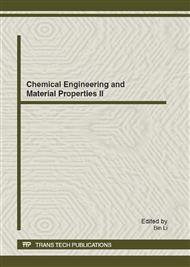[1]
J.N. Barici, G.G. Wallace and D.R. Macfarlane: Eletrochem. Commun Vol. 22-27(2004), p.6.
Google Scholar
[2]
K. Lmoto, K. Takahashi and T. Yamaguchi ect: Sol. Energy Mater. Sol. Cells Vol. 459-469 (2003), p.79.
Google Scholar
[3]
D. Zielinska, B. Pierpzynski: submitted to Journal of Electroanalytical Chemistry (2009).
Google Scholar
[4]
A. Safavi, N. Maleki: Eletrochemistry. Commun Vol. 1113-1115 (2009), p.11.
Google Scholar
[5]
Y.X. Zhang, X.J. Zhang: Chem. Eng. Prog Vol. 1700-1704 (2010), p.29.
Google Scholar
[6]
J.C. Qiao, X.L. Hu and P. Guan: Chin. J. Polym. Sci Vol. 45-47 (2006), p.7.
Google Scholar
[7]
X.Y. Duan, L.M. Chang and L. Liu: Environ. Sci. Technol Vol. 63-66 (2010), p.5.
Google Scholar
[8]
C.L. Liu, W.S. Dong and G.P. Cao ect: submitted to Journal of Electroanalytical Chemistry Vol. 225–231(2007), p.611.
Google Scholar
[9]
B.G. Li, H.B. Liu and L. Zhang: Carbon Vol. 16-19 (2004), p.4.
Google Scholar
[10]
X.H. Xia, H.B. Liu and J. Chen: Funct. Mater Vol. 2023-2026 (2009), p.40.
Google Scholar
[11]
S.J. Hong: New. Chem. Mater Vol. 26-28 (2002), p.11.
Google Scholar
[12]
Q. Zhao: Preparation of Carbon/ptfe CompositeConductive Material and Research of properties. Chapter 2, edited by Excellent Dissertation Database Publishers, China (2009).
Google Scholar
[13]
K. Dai, L.Y. Shi: Mater. Sci. Technol Vol. 602-605 (2007), p.15.
Google Scholar
[14]
U. Lappan, U. Geiûler and K. Lunkwitz: Rad. Phy. Chem Vol. 317-322. (2000), p.59.
Google Scholar
[15]
J.Y. Zhang, X.K. Li and Q.H. Wang: Eng. Plast. Appl Vol. 79-81 (2008), p.12.
Google Scholar
[16]
J.B. Lee, K.K. Park and S.W. Yoon: Desalination Vol. 155-161 (2009), p.237.
Google Scholar
[17]
J.Y. Choi, J.H. Choi: submitted to Journal of Industrial and Engineering Chemistry (2010).
Google Scholar
[18]
B. Xu, S.S. Hou and M. Chu: submitted to Journal homepage carbon (2010).
Google Scholar
[19]
C.H. Hou, F. Huang: submitted to Journal of the Taiwan Institute of Chemical Engineers (2011).
Google Scholar
[20]
K.Y. Foo, B.H. Hameed: submitted to Journal of Hazardous Materials (2009).
Google Scholar
[21]
K.K. Park, J.B. Lee and P. Park: Desalination Vol. 86-91 (2007), p.26.
Google Scholar
[22]
B.H. Park, J.H. Cho: Electrochem. Acta Vol. 2888-2893 (2010), p.55.
Google Scholar
[23]
J.S. Kim, J.H. Choi: submitted to Journal of Membrane Science Vol. 85-90 (2010), p.355.
Google Scholar
[24]
Y.J. Kim, J.H. Choi: Sep. Purif. Techol Vol. 70-75 (2010), p.71.
Google Scholar
[25]
Y.J. Kim, J.H. Choi: Water. Res Vol. 990-996 (2010), p.44.
Google Scholar


